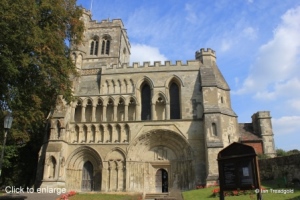To my regret I have not so far had the opportunity to visit the remains of Dunstable Priory in Bedfordshire. Today only the nave survives of the Augustinian’s church. However that still preserves a spectacular west front.
The west front and doorway of Dunstable Priory
Images: bedfordshireparishchurches.co.uk
Its special place in English and ecclesial history is that it was in the Lady Chapel of the canon’s church that Cranmer pronounced the annulment of the marriage of King Henry VIII and Queen Catherine of Aragon on May 23 1533. There is more about this from Heritage Daily at The Annulment of Henry VIII to Catherine of Aragon at Dunstable Priory
After the dissolution of the priory it was one of those former monastic churches listed as potential cathedrals for new dioceses - in this case for Bedfordshire - but that did not come about and all that survives is the parochial nave.
Wikipedia has a particularly detailed account of the history of the house at Dunstable Priory
There is a well illustrated account of the architecture of the church at Dunstable – Priory Church of St Peter from Bedfordshire Parish Churches
Medievalists.net has a report about a recent geophysical survey of the site of the presbytery and Lady Chapel which clearly suggests that the church was more impressive than had been hitherto thought - though with a West facade like that which survives perhaps one should not be surprised. What the survey indicates looks very like the plan of the east end of the similarly Augustinian Great St Bartholomew at Smithfield - though part of that is a skilful Victorian reconstruction. The illustrated Medievalists.net article can be seen at New survey of Dunstable Priory reveals a grander complex

The choir and presbytery of St Bartholomew Smithfield may suggest what was once the appearance of the priory church in Dunstable.
Image: lookup.london




No comments:
Post a Comment